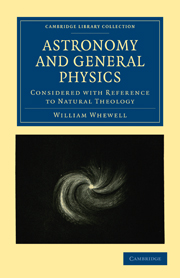Book contents
- Frontmatter
- NOTICE
- Contents
- INTRODUCTION
- BOOK I TERRESTRIAL ADAPTATIONS
- BOOK II COSMICAL ARRANGEMENTS
- CHAP. I The Structure of the Solar System
- CHAP. II The Circular Orbits of the Planets round the Sun
- CHAP. III The Stability of the Solar System
- CHAP. IV The Sun in the Centre
- CHAP. V The Satellites
- CHAP. VI The Stability of the Ocean
- CHAP. VII The Nebular Hypothesis
- CHAP. VIII The Existence of a Resisting Medium in the Solar System
- CHAP. IX Mechanical Laws
- CHAP. X The Law of Gravitation
- CHAP. XI The Laws of Motion
- CHAP. XII Friction
- BOOK III RELIGIOUS VIEWS
CHAP. VIII - The Existence of a Resisting Medium in the Solar System
from BOOK II - COSMICAL ARRANGEMENTS
Published online by Cambridge University Press: 05 August 2011
- Frontmatter
- NOTICE
- Contents
- INTRODUCTION
- BOOK I TERRESTRIAL ADAPTATIONS
- BOOK II COSMICAL ARRANGEMENTS
- CHAP. I The Structure of the Solar System
- CHAP. II The Circular Orbits of the Planets round the Sun
- CHAP. III The Stability of the Solar System
- CHAP. IV The Sun in the Centre
- CHAP. V The Satellites
- CHAP. VI The Stability of the Ocean
- CHAP. VII The Nebular Hypothesis
- CHAP. VIII The Existence of a Resisting Medium in the Solar System
- CHAP. IX Mechanical Laws
- CHAP. X The Law of Gravitation
- CHAP. XI The Laws of Motion
- CHAP. XII Friction
- BOOK III RELIGIOUS VIEWS
Summary
The question of a plenum and a vacuum was formerly much debated among those who speculated concerning the constitution of the universe; that is, they disputed whether the celestial and terrestrial spaces are absolutely full, each portion being occupied by some matter or other; or whether there are, between and among the material parts of the world, empty spaces free from all matter, however rare. This question was often treated by means of abstract conceptions and à priori reasonings; and was sometimes considered as one in which the result of the struggle between rival systems of philosophy, the Cartesian and Newtonian for instance, was involved. It was conceived by some that the Newtonian doctrine of the motions of the heavenly bodies, according to mechanical laws, required that the space in which they moved should be, absolutely and metaphysically speaking, a vacuum. This, however, is not necessary to the truth of the Newtonian doctrines, and does not appear to have been intended to be asserted by Newton himself. Undoubtedly, according to his theory, the motions of the heavenly bodies were calculated on the supposition that they do move in a space void of any resisting fluid; and the comparison of the places so calculated with the places actually observed, (continued for a long course of years, and tried in innumerable cases,) did not shew any difference which implied the existence of a resisting fluid.
- Type
- Chapter
- Information
- Publisher: Cambridge University PressPrint publication year: 2009First published in: 1833



